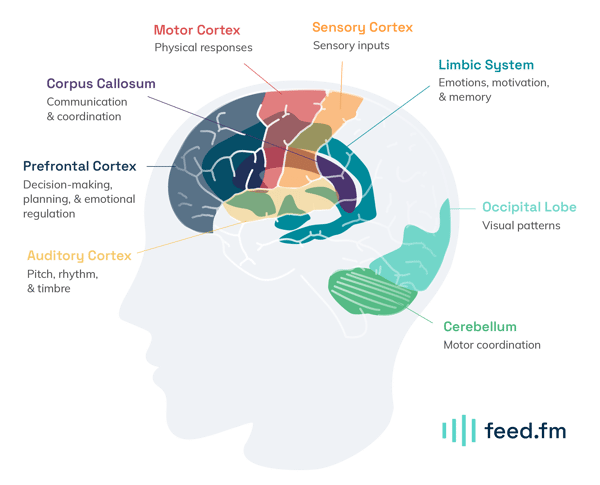Music and the Brain

We’re all familiar with how music can very quickly get us energized or into a better mood—to “turn that frown upside down.” How exactly does music accomplish this? By becoming aware of the dynamic interplay between music and the brain, we can make the most of music’s physiological effects to enjoy our lives more and perform at our best.
Music initiates a cascade of powerful changes in the brain, with both short-term and long-term impacts in the areas of motivation, memory, focus, relaxation, mood enhancement, and more. By understanding these changes and intentionally using music to support optimal functioning, we can improve many aspects of our lives, including sleep, athletic performance, cognitive focus, and mood.
According to a qualitative research study on music and brain health, respondents who listened to music regularly self-reported higher levels of happiness, cognitive function, well-being, and slightly lower rates of anxiety and depression. How is it possible that listening to music can do all that? Let’s look at the neuroscience of music: what are the pathways by which music catalyzes these changes?
Neuroscience of music
Sex, drugs, and rock ‘n’ roll…what do they have in common? All contribute to the brain’s production and release of dopamine, a neurotransmitter that plays a role in feelings of pleasure and reward.
Neurologically, humans are hard-wired to respond in predictable ways to music. Music is a powerful stimulus for the nervous system, affecting core brain pathways that regulate mood, reward, arousal, stress, and anxiety. Listening to music can amplify our good mood and motivation, and it can also decrease feelings of stress, anxiety, and depression.
How does this work? In the case of stress and anxiety, many studies examining the neuroscience of music have looked at self-reported stress and anxiety levels and biomarkers of stress like cortisol. They have compared relaxing with and without music, and what can be seen across these studies is that the music conditions are consistently associated with significantly lower levels of psychological and physiological stress, indicating that music can play a strong and active role in mitigating these states.
Excerpt from "The Science of Music as Medicine" a webinar with Dr. Daniel Bowling, a neuroscientist and instructor at Stanford University, and Feed.fm functional music advisor. Watch the full webinar here.
Emerging field of biomusicology
Interest in the scientific and clinical applications of music has been steadily growing: in the year 2000, there were 500 scientific research articles on the topic of music; in 2020, there were 1,000; and in 2022, almost 3,000. This increased focus benefits our understanding of the relationship between music and the brain.
The advances in research have led to the creation of a new discipline at the intersection of music and human biology: “biomusicology,” which draws on and synthesizes work across auditory and social neuroscience, the psychological study of music, music cognition, acoustics, and signal processing.
Progress has been aided by technological innovation in brain imaging, particularly fMRI (functional Magnetic Resonance Imaging), which has allowed scientists to measure activity throughout the brain during musical stimulation.

Your brain on music
Research has shown that music profoundly impacts the brain, engaging various regions and networks in complex ways. Here are some of the key parts of the brain that perceive, process, and respond to music:
- Auditory Cortex: Primarily responsible for processing auditory information; deciphers elements like pitch, rhythm, and timbre when we listen to music.
- Prefrontal Cortex: Central to decision-making, planning, and emotional regulation. Music can trigger emotions and memories, thereby activating and influencing this region.
- Limbic System: Comprising structures such as the amygdala and hippocampus, this system is at the heart of our emotions, motivation, and memory. Music deeply resonates with these emotional centers, enhancing experiences and aiding in memory formation.
- Motor Cortex: Stimulated by rhythmic elements in music, it drives physical responses, such as moving with the music or the tapping of feet.
- Sensory Cortex: Processes various sensory inputs from our body, including touch; engaged when musicians touch their instruments or dancers connect with the ground or their dance partner.
- Cerebellum: Controls motor coordination and plays a role in deciphering rhythm and timing in music, helping us keep in time with a beat.
- Corpus Callosum: The bridge between the brain's two hemispheres; music encourages communication and coordination across this bridge.
- Occipital Lobe: The hub for visual processing, activated when musicians read sheet music, dancers observe choreography, or when visual patterns accompany music—during a live concert, for example.
- Default Mode Network (DMN): This network is associated with introspection, daydreaming, and self-referential thoughts. Music can influence the activity of the DMN, potentially leading to a state of increased self-awareness and reflection.
- White Matter Tracts: Long-term musical training has been shown to impact the integrity of white matter tracts, which are responsible for communication between different brain regions. Musicians often exhibit enhanced connectivity in these tracts, which can lead to improved cognitive abilities.
Functional music, mood, and performance
Understanding how the brain processes and interprets music can be extremely useful when using music as a tool for better mood and performance. Functional music is any music that is used for a purpose other than sheer enjoyment or entertainment, and most effective functional music relies heavily on an understanding of the effects of music on the brain. Functional music includes music played for wellness outcomes, including relaxation, sleep, meditation, stress reduction, athletic training, and focus.
“The right music can stimulate reward, reduce stress, and improve mood, putting your brain in a position to better achieve many wellness outcomes, such as quieting anxiety."
Daniel Bowling, PhD
Instructor, Department of Psychiatry and Behavioral Sciences, Stanford School of Medicine | Feed.fm Wellness Advisor
Effectively curated functional music has the potential to greatly improve the lives of many people at a minimal cost and with no side effects. Powerful applications of functional music include reducing stress and anxiety, assisting in relaxation and falling asleep, alleviating depression, and improving overall mood. Functional music can also enhance focus and productivity for study and work.
The relation of music to mood and performance is connected to our perception of musical tone and rhythm.
Tone
Our brains are extremely sensitive to the emotional nuances of the human voice and human vocal tones. From a biological perspective, distinguishing between gentle and angry voices quickly has real survival value. When we hear tones in music, our brains process them in a similar way, perceiving melodies and harmonies as a form of communication. Thus, music with gentle tones may be interpreted as soothing and relaxing, and playing relaxing music can have a powerful effect on bringing down stress and anxiety levels.

Rhythm
Humans exhibit a tendency to move in response to rhythm. Neural Resonance Theory (NRT) explains that rhythm perception relies on the entrainment of neural responses to sound and describes how rhythm can couple together brain activity in parts of the brain that process sound and movement.
Rhythm can be utilized as a means of enhancing focus for creative and cognitive work and for generating motivation before or during such tasks. The arousal-and-mood hypothesis describes the way that music improves performance both by increasing arousal and alertness and also by enhancing mood.
The powerful effects of rhythm to supply motivation and energy have long been implemented in traditional songs used to accompany physical labor and work to lift spirits, coordinate efforts, and provide a positive distraction from the monotony of a task.

Functional music selection
Choosing the optimal functional music for the task is key to getting the best results from music’s effects on the brain. As noted earlier, specific parameters for functional music depend on whether it is intended to support relaxation, sleep, focus, or athletic performance. Expert music curation to determine the ideal ranges for the functional music’s rhythm, tone, bpm, and other musical qualities is extremely valuable to ensure that you’re employing the best music for the job.
If you’re considering adding functional music to your company’s app, an experienced partner can help you make light work of what could otherwise be Herculean tasks, including music licensing, curation, streaming, and tracking. Feed.fm has been helping businesses license and integrate music into their apps for nearly a decade, serving as a one-stop shop that handles every aspect of the process from beginning to end.
Feed.fm makes getting functional music onto your app as easy as possible with a comprehensive, turnkey solution that includes pre-cleared music—both commercial hits and science-backed, royalty-free soundscapes. Our team of experts work as an extension of your team, making sure that you're selecting the right music for your app.
Best of all, the Feed.fm streaming music API and plug-and-play SDKs (iOS, Android, Javascript, React Native, and Unity) make it easy to stream and track usage while automating all compliance and reporting.
A member of the expert team at Feed.fm would be happy to talk with you about how incorporating functional music or music for wellness and optimal performance can take your app to the next level.


 2 min
2 min